Prof/Dr Louis Zalman Glick Touyz1*
1Emeritus Director and Professor, Periodontics, McGill University, Faculty of Dental Medicine and Oral Health Sciences, Montreal, PQ, Canada
*Corresponding Author: L.Z.G. Touyz, Emeritus Director and Professor, Periodontics, McGill University, Faculty of Dental Medicine and Oral Health Sciences, Montreal, PQ, Canada; Email: [email protected]
Published Date: 09-09-2022
Copyright© 2022 by Touyz LZG. All rights reserved. This is an open access article distributed under the terms of the Creative Commons Attribution License, which permits unrestricted use, distribution, and reproduction in any medium, provided the original author and source are credited.
Abstract
Pop-drinks are promoted aggressively for consumption and profits. Most are mixtures of phosphoric acid with (CO2) gas, sugars and flavorings. Sugar-free drinks remain acid even when flavored by synthetic sweeteners. Most have acidities (pH below 5.5) which decalcify teeth, after ingestion. Pop-drinks cause erosion decalcification without bacterial action. Caries starts as decalcification with consequent cavitation by bacterial invasion. Saliva neutralizes dietary acids within 30 minutes. Repeated sips of colas keep mouth and oral biofilm acidity low and long enough to start decalcification. Evidence of decalcification from pop-drinks are exiguous; this appraisal cites research that implicates pop-drinks, specifically colas and guarana, in causing decalcification and by extrapolation, also consequent dental erosion and tooth decay.
Keywords
Acidity; Caries; Cola; Critical-pH; Decay; Decalcification; Pop-Drinks
Introduction
Pop-drinks, specifically colas, are promoted aggressively to increase consumption and profits for the manufacturers. Most pop-colas are mixtures of phosphoric acid with dissolved Carbon Dioxide (CO2) gas, sugars like sucrose or fructose and added flavorings. Sugar-free ‘diet’ colas are still acid mixtures and the fermentable carbohydrates are replaced by synthetic sweeteners. Most of these pop-colas have acidities (pH below 5.5) which will decalcify teeth and with chronic ingestion of pop-drinks will cause erosion defined as decalcification of teeth material without bacterial action or cavitation. Tooth decay starts as a nidus of decalcification, which with subsequent invasion of bacteria causes further decalcification and cavitation and progresses to dental caries [1-6]. Saliva will usually neutralize dietary acids, or acids produced from oral bacterial action on fermentable carbohydrates in the diet, within 30 minutes [7]. Repeated sips of acidulated colas, keeps the oral acidity in oral biofilms low and long enough to start decalcification [1-8]. Cohesive evidence for erosion derived from chronic decalcification by pop-colas are exiguous.
Aim
This appraisal deconstructs reported evidence derived from research that implicates pop-drinks with cola-based formulae, in causing the dental ravages of dental decalcification resulting in tooth erosion, attrition, abrasion and decay. Acidity, buffering capacity of Colas are highlighted and calcium analysis after dentate and edentulous subjects rinsing with colas are indicated and discussed.
Evidence from Research
The critical pH of Cola-Pop Sodas: The critical pH at which dental calcified material decalcifies is pH5.5->pH 6.5. The pH of colas (and guarana-pop soda, which is similar to Colas) is well below pH5.5 (Fig. 1) [2,24].

Figure 1: The acidity of Colas as pH. All are below the critical pH 5.5 [2,24].
It is important to know how much alkali it takes to raise an aliquot of Cola, equivalent to a mouthful of Colas by one pH unit and to pH 5.5, the critical pH for decalcification and to neutral pH of 7.00 (Fig. 2-5) [2,24].

Figure 2: The amount of alkali (0.5N NaOH) to raise the pH one unit [2,24].

Figure 3: The amount of alkali (0.5N NaOH) to raise the pH to pH 5.5 [2,24].

Figure 4: The amount of alkali needed to raise the pH of Colas to pH 7. The oral environment is considered neutral. Accordingly, it is important to know how much alkali it takes to neutralize Cola to pH 7 [2,24].

Figure 5: Acidities compared to common liquids. Colas pH in Blue are all below the critical pH of 5.5 [9].
Experimental Evidence
A critical experiment measured calcium from the cans and then compared the calcium content of a mouthful of Cola after swishing for 30 seconds. Results obtained from a cohort with teeth, were compared to a cohort WITHOUT teeth. The experimental design was as follows (Fig. 6).

Figure 6: Experimental design for comparison of colas before and after swishing in cohorts one with teeth and second without teeth [2,24].
Calcium leeched from the dentate cohort was measured using Inductively Coupled Plasma with Optical Emission Spectroscopy (ICP-OES). Results showed significantly increased (p<0.01 Student-t) from the dentate subjects after swishing with all the pop-colas tested. Hard tissue erosion, as chemical dissolution of calcium without bacterial action, varies between colas. Decalcification is consistently and significantly (p<0.01 Student-t) produced, from post-swishing exposure to pop-colas (Fig. 7).

Figure 7: The columns on the left shows calcium content from the cans. The middle columns show calcium from swishes of cola without teeth. The columns on the right show calcium contents of colas after being swished in mouths with teeth. The calcium contents in swished colas are significantly (p<0.01) higher compared to swished colas from edentulous subjects [2,24].
It is known that Fluoride ions at 1ppm, in potable municipal drinking water reduces the prevalence of caries [8-11]. There is fluoride in Colas. The total fluoride in Colas was measured using the Association of Official Agricultural Chemists (AOAC) Method 944.08 to determine the total fluoride (Fig. 8).

Figure 8: Fluoride content of Colas. Fluoride content in pop-colas (n=12) direct from the cans. The above graph shows the Fluoride concentration (mg/L or parts per million ppm) in six Cola drinks tested. Pepsi has the highest concentration (6.3 ppm) while diet Coke has the lowest concentration (1.96 ppm) [2,24].
Discussion
The admitted major content of all pop-colas is phosphoric acid, with water and flavorings. The acidity is augmented from a miniscule amount (about 0.002->0.003 % of dissolved CO2 that forms H2CO3 in water; this ionizes and adds extra hydrogen ions to the acid mix. The colas are bottled under pressure and when exposed to air, the CO2 is released as bubbles which combined with the flavorings and acid in the drink to impart the pleasurable sensation of imbibing cola.
The admitted major content of all pop-colas is phosphoric acid, with water and flavorings. The acidity is augmented from a miniscule amount (about 0.002->0.003 % of dissolved CO2 that forms H2CO3 in water; this ionizes and adds extra hydrogen ions to the acid mix. The colas are bottled under pressure and when exposed to air, the CO2 is released as bubbles which combined with the flavorings and acid in the drink to impart the pleasurable sensation of imbibing cola.
These results indicate that acidulated pop-colas do decalcify teeth. The average can of 350 mls, is assumed to be consumed in at least seven or more gulps, within half an hour or less. The oral pH will be kept low enough during this period to allow for decalcification. The swishes of 50 mls, were for 30 seconds’ this time is the equivalent sum of seven 50 mls swallows, with exposure times of about 4.15 seconds per swallow (7 X 4.12 = ~ 30 seconds). The edentulous (without teeth) comparison cohort were much older at 55 years (mean 55 +/- 5 range 50-60) than the Dentate (with teeth) exposed group, because an age matched control at 23 years (mean (+/- 3; range 19-25) was impossible to procure.
These results indicate that acidulated pop-colas do decalcify teeth. The average can of 350 mls, is assumed to be consumed in at least seven or more gulps, within half an hour or less. The oral pH will be kept low enough during this period to allow for decalcification. The swishes of 50 mls, were for 30 seconds’ this time is the equivalent sum of seven 50 mls swallows, with exposure times of about 4.15 seconds per swallow (7 X 4.12 = ~ 30 seconds). The edentulous (without teeth) comparison cohort were much older at 55 years (mean 55 +/- 5 range 50-60) than the Dentate (with teeth) exposed group, because an age matched control at 23 years (mean (+/- 3; range 19-25) was impossible to procure.
Fluoride in high concentrations in water will significantly reduce caries formation, but from the results in Fig. 8, it appears the protective effect against dental decalcification is overwhelmed by the acid activity in colas.
Further confirmation that acidulated pop-sodas decalcify teeth are corroborated by research on a similar drink, namely Guarana and also from important anecdotal or reported clinical case reports [1,3,15,16]. Excess imbibing of pop-drinks may produce other serious morbidities, like esophageal dysplasia, obesity and diabetes mellitus [17].
The only rational explanation for the significant increase in calcium after swishing with Colas is that the calcium was derived from the exposed teeth. This repeated exposure to Pop-soda leads to erosion from decalcified hard tissues. Physical friction from mastication of foods and/or brushing will remove the softened decalcified tooth-material and produce erosion. The decalcified occlusal and incisal surfaces will also be lost and lead to attrition [1,15-17]. If an acid-drink is frozen, an ice skeleton forms and a super-saturated solution of acidic ions form, so that it takes more alkali to neutralize the remainder acid drink [19,20]. Should dentin which is less calcified than enamel, be exposed at the cervical margins by the horizontal-scrub-method of brushing, it will produce cervical abrasion and often be accompanied by pain from exposed dentine [3,19,20]. Loci of decalcification may form in stagnating areas, like in pits and fissures, or at interproximal contact points and become attacked by oral biofilm microbes [21]. This will lead to cavitation and progressive damage to the teeth from caries. Recognition and management of these ravages have been reported elsewhere [21,22]. Recognition of biofilm and measuring intra-plaque biofilms pH has been facilitated by disclosing dyes and telemetry [13,23,25].
Conclusion
Imbibing colas is causatively associated with dental erosion, attrition, abrasion and tooth decay. These are major ravages to dental health. One of the major manufacturers of pop-Cola claims: ‘Things go better with (Coca-) Cola!’ That may be true for other things but not for teeth.
Conflict of Interest
The authors report no conflict of interest.
References
- Touyz LZG, Mehio A. Dental ravages from acidulated soft drinks. J Aesthetic and Implant Dentistry. 2006;8(3):20-33.
- Touyz LZG pH acidity and Erosion from Pop Cola. IADR Conference Barcelona. J Dental Res. 2010.
- Ferrari CI, Touyz LZG. Clinical implications from an in-vitro and in-vivo investigation of acidity, erosion and pain from common pop-acidulated drinks: Cola and Guaraná drinks. Int J Clin Dent. 2013;6(3):279-90.
- Touyz LZG. The pathophysiology of oral biofilms and it’s relation to initial gum disease and caries. J Dent Oral Disor Ther. 2017;5(3):1-6.
- Deo PN, Deshmukh R. Oral microbiome: Unveiling the fundamentals. JOMFP. 2019;23(1):122.
- Berger D, Rakhamimova A, Pollack A, Loewy Z. Oral biofilms: development, control, and analysis. High-Throughput. 2018;7:24.
- Buskermolen JK, Janus MM, Roffel S, Krom BP, Gibbs S. Saliva-derived commensal and pathogenic biofilms in a human gingiva model. J Dental Research. 2018;97(2):201-8.
- Touyz LZG. Patterns of hard tissue dental abfractions as indicators of extrinsic etiologies. Scientific Archives of Dental Sciences. 2019;2:21-4.
- Tenuta LM, Cury JA. Fluoride: its role in dentistry. Brazilian Oral Research. 2010;24:9-17.
- Cevedo AM. Role of fluoride in dental caries and risk management. Oral Health Network. Colgate. 2015;1-21.
- Touyz LZG, Nassani LM. Does fluoridated municipal water reduce prevalence of tooth caries? Fluoridated water DMFT compared with Non-fluoridated DMFT in the greater Montreal area. A clinical epidemiological study. J Pharm Pharm Sci. 2019;8(6):15-25.
- Touyz LZG, Nassani LM. Affirmation: fluoridated water reduces caries in children. Jnl Pediatric Dentistry and Hygiene. Jnl Pediatric Dentistry and Hygiene. 2019;1(1):1003.
- Imfeld T, Lutz F. Intraplaque acid formation assessed in vivo in children and young adults. Pediatr Dent. 1980;2(2):87-93.
- Touyz LZG, Touyz SJ, Nassani LM. Acidic and alcoholic beverages and teeth and clinical advisories. EC Dental Science. 2018;17(10):1759-65.
- Touyz LZG, Touyz SJJ, Nassani LM. Acidity and dental erosion from apple and grape-juice. (An in-vitro and in-vivo report). International Jnl Oral and Dental Health. 2018;4(61):1-7.
- Touyz LZG. The acidity (pH) and buffering capacity of Canadian fruit juice and dental implications. J Canadian Dental Association. 1994;60(5):454-8.
- Touyz LZG, Afrashtehfar KI. Soft drink consumption: innocent indulgence or dangerous drinking habit? Smile Dental J. 2016;11(4).
- Touyz LG, Silove M. Increased acidity in frozen fruit juices and dental implications. J Dentistry for Children. 1993;60(3):223-5.
- Touyz LZG, Silove M. Frozen fruit juices as a potential cause of dental hypersensitivity. Archives of Oral Biology. 1994;39:S130.
- Renton T. Dental (Odontogenic) pain. British J Pain. 2011;5(1):2-7.
- Liu B. Use of topical fluorides and resin sealant in preventing dental cariesin pits and fissures. HKU Theses Online (HKUTO). 2011.
- Fejerskov O, Nyvad B, Kidd EA. Dental caries: what is it? Dental caries: the disease and its clinical management. 2015:7-10.
- Datta D, Kumar SR, Narayanan A, Selvamary AL, Sujatha A. Disclosing solutions used in dentistry. World J Pharm Res. 2017;6(6):1648-56.
- Borjian A, Ferrari CC, Anouf A, Touyz LZG. Pop-cola acids and tooth erosion: an in-vitro, in-vivo, electron-microscopic, and clinical report. Int J Dentistry. 2010.
- Touyz LZG. Quaffing colas and fruit juices. Scien Arch of Dental Sci. 2022;21:6.
Article Type
Research Article
Publication History
Received Date: 06-08-2022
Accepted Date: 02-09-2022
Published Date: 09-09-2022
Copyright© 2022 by Zalman L, et al. All rights reserved. This is an open access article distributed under the terms of the Creative Commons Attribution License, which permits unrestricted use, distribution, and reproduction in any medium, provided the original author and source are credited.
Citation: Touyz LZG. Things Go Better With Cola? Not For Teeth. J Dental Health Oral Res. 2022;3(3):1-8.
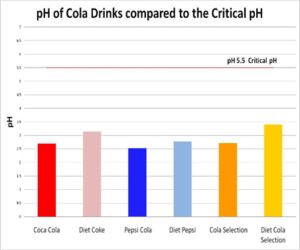
Figure 1: The acidity of Colas as pH. All are below the critical pH 5.5 [2,24].
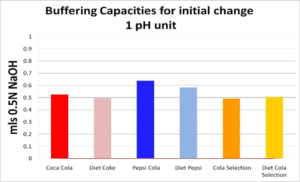
Figure 2: The amount of alkali (0.5N NaOH) to raise the pH one unit [2,24].
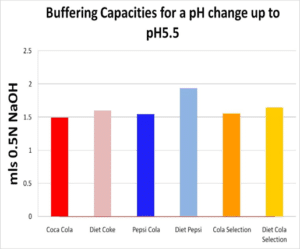
Figure 3: The amount of alkali (0.5N NaOH) to raise the pH to pH 5.5 [2,24].
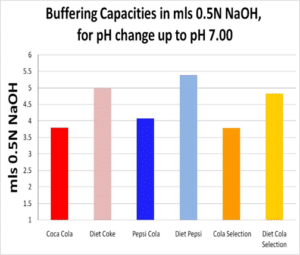
Figure 4: The amount of alkali needed to raise the pH of Colas to pH 7. The oral environment is considered neutral. Accordingly, it is important to know how much alkali it takes to neutralize Cola to pH 7 [2,24].
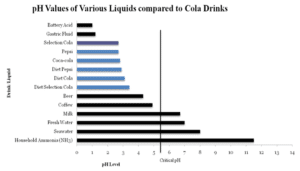
Figure 5: Acidities compared to common liquids. Colas pH in Blue are all below the critical pH of 5.5 [9].
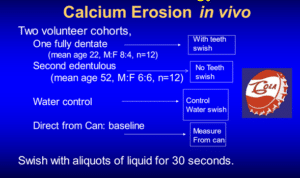
Figure 6: Experimental design for comparison of colas before and after swishing in cohorts one with teeth and second without teeth [2,24].
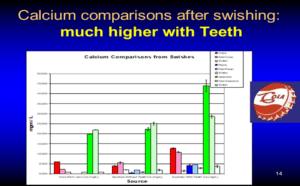
Figure 7: The columns on the left shows calcium content from the cans. The middle columns show calcium from swishes of cola without teeth. The columns on the right show calcium contents of colas after being swished in mouths with teeth. The calcium contents in swished colas are significantly (p<0.01) higher compared to swished colas from edentulous subjects [2,24].
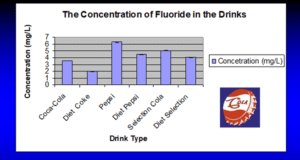
Figure 8: Fluoride content of Colas. Fluoride content in pop-colas (n=12) direct from the cans. Th above graph shows the Fluoride concentration (mg/L or parts per milli ppm) in six Cola drinks tested. Pepsi has the highest concentration (6.3 ppm) while diet Coke has the lowest concentration (1.96 ppm) [2,24].


